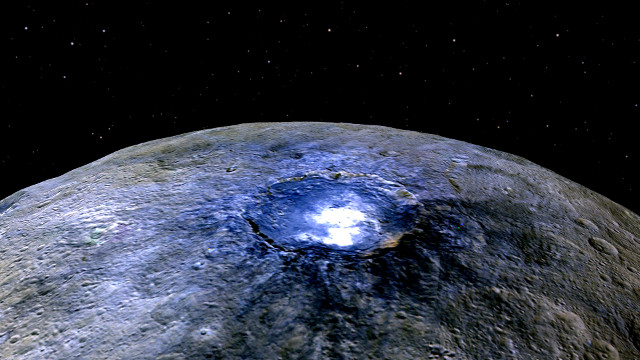
Two studies published in the journal “Nature” offered new interesting information about the dwarf planet Ceres. Thanks to analyzes of data collected by NASA’s Dawn space probe the authors of these studies claim that the mysterious white spots are composed of salts and that on Ceres there are ammonia-rich clays. The explanations about the materials that make up the white spots may solve a mystery while the presence of ammonia creates another, linked to the origin of this dwarf planet.
A team led by Andreas Nathues at Max Planck Institute for Solar System Research in Göttingen, Germany, studied the now famous white spots of Ceres. The ones in the crater Occator are particularly large but there are over 130 on the dwarf planet. According to the authors of this research the brilliant material in the crater Occator is compatible with a magnesium sulfate called hexahydrite.
The scientists also used observations made with the Herschel space telescope that showed the presence of water vapor on Ceres. Putting together all the available data, they reconstructed a water cycle similar to what exists on comets surface. The water ice sublimates during the day becoming vapor and freezes at night and during the transition brings with it other materials.
Hazes were found in the crater Occator that confirm this kind of phenomenon and the analysis of the crater suggests that there may be temporarily even liquid water. This may seem strange considering that of Ceres the atmospheric pressure is almost non-existent but the presence of salts can greatly alter the temperature range in which water can be a liquid.
According to the researchers these continuous state transitions left a considerable amount of salt on the surface of the crater Occator. The result is that today we see these huge white spots. This could have happened in the other brilliant areas of Ceres as well but being generally much smaller they’re more difficult to analyze.
Further research will also cover the origin of water ice. If it had been brought by comets after the formation of Ceres it would’ve remained on the surface quickly sublimating. It’s an issue to be examined, such as the presence of ammonia-rich clays described in a research led by Maria Cristina De Sanctis, INAF – IAPS, scientific director of the Dawn space prob’s VIR spectrometer.
Ammonia was detected in the Pluto system and on other trans-Neptunian celestial bodies so finding it on Ceres is surprising. Again, the ice can’t be on Ceres surface because it would quickly sublimate and by now would be exhausted. One possibility is that the ammonia ice is combined with other minerals that give it a greater thermal stability like salts do with ice water.
The most intriguing hypothesis is that Ceres formed beyond the orbit of Neptune, where ammonia and water are plentiful. In this case, it makes sense that during the formation of Ceres these substances ended up in what is now the dwarf planet’s underground during its growth.
In recent days, the Dawn spacecraft reached its final orbit, the lowest at an altitude of 385 kilometers (240 miles) above the dwarf planet Ceres surface. In the coming days, it will begin a new series of observations that will provide even more detailed information hoping to solve the new mysteries.
[ad name=”eBayUSUKNASA”]


Permalink
Permalink
Permalink
Permalink
Permalink